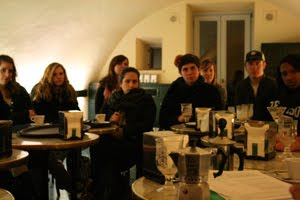 Umbra Institute students last night enjoyed more than a hot cup of Joe. Umbra staff member Mauro Renna and history prof Zachary Nowak entertained students who participated in the Coffee Workshop, offered as part of Umbra’s extra-curricular series of food workshops. Renna and Nowak described the convoluted and often odd history of that bean which lets us start our mornings, from its domestication in Ethiopia and export from the Yemenese port of (get this!) Al-Moka, through its arrival in Venice and quick spread through Europe.
Umbra Institute students last night enjoyed more than a hot cup of Joe. Umbra staff member Mauro Renna and history prof Zachary Nowak entertained students who participated in the Coffee Workshop, offered as part of Umbra’s extra-curricular series of food workshops. Renna and Nowak described the convoluted and often odd history of that bean which lets us start our mornings, from its domestication in Ethiopia and export from the Yemenese port of (get this!) Al-Moka, through its arrival in Venice and quick spread through Europe.

History gave way to botany (Coffea arabica vs Coffee robusta, the two main species), processing, and even a little economics (coffee is the #2 most-traded product behind petroleum in dollar value). The workshop ended with a tasting of six different coffees and an explanation of their “cultural context”: Italians rarely drink cappucino after 11am, and coffee in a glass cup is considered more elegant. Renna finished up the night with a demonstration of how to us the “moka,” which in Italian refers to the Italian coffee pot, not a drink with chocolate.
The next workshop is Aperitivo 101, next Tuesday!



 Perugia has about a 3 to 1 ratio of nooks to crannies, Umbra Institute students found out yesterday. Sunday afternoon saw two editions of the “almost internationally-renowned” (as history professor Zachary Nowak describes it) tour of Perugia. Nowak took the students on a sun-drenched traipse around Perugia’s center, recounting anecdotes and stories about monuments and people in Perugia’s past.
Perugia has about a 3 to 1 ratio of nooks to crannies, Umbra Institute students found out yesterday. Sunday afternoon saw two editions of the “almost internationally-renowned” (as history professor Zachary Nowak describes it) tour of Perugia. Nowak took the students on a sun-drenched traipse around Perugia’s center, recounting anecdotes and stories about monuments and people in Perugia’s past. television special, but it was his expertise in the technique known as buon fresco that got him involved in this particular project. Buon fresco is a process, perfected in the fifteenth century in Italy, of painting on a wet lime-mortar covered wall. Michelangelo, Leonardo, and Raffaelo all used it—and William Pettit teaches it. Pettit was asked to participate in the episode on the Vatican Museums, which discusses Michelangelo’s frescoes in the Sistine Chapel.
television special, but it was his expertise in the technique known as buon fresco that got him involved in this particular project. Buon fresco is a process, perfected in the fifteenth century in Italy, of painting on a wet lime-mortar covered wall. Michelangelo, Leonardo, and Raffaelo all used it—and William Pettit teaches it. Pettit was asked to participate in the episode on the Vatican Museums, which discusses Michelangelo’s frescoes in the Sistine Chapel. over-hundred strong student body members got to Rome’s Fiumicino airport on Friday, yesterday was the real beginning of their Umbra experience. The day began with housing: students were taken in taxis from the hotel where they had stayed and had their Welcome Dinner to their apartments up in Perugia’s beautiful historic center. Some apartments have frescoes, some have majestic views (often four flights up, but worth the sweat!), but all are our “temporary citizens” homes for the next four months.
over-hundred strong student body members got to Rome’s Fiumicino airport on Friday, yesterday was the real beginning of their Umbra experience. The day began with housing: students were taken in taxis from the hotel where they had stayed and had their Welcome Dinner to their apartments up in Perugia’s beautiful historic center. Some apartments have frescoes, some have majestic views (often four flights up, but worth the sweat!), but all are our “temporary citizens” homes for the next four months. main piazza. There was a greeting from Resident Director Anna Girolimetti and an introduction from Professor Elgin Eckert. The third speaker was Officer Michele Canneschi, who talked to the students on behalf of the Italian police forces about safety and security in Italy. Today, students will get additional information in their break-out orientation meetings with staff members, then ask questions during the Open House.
main piazza. There was a greeting from Resident Director Anna Girolimetti and an introduction from Professor Elgin Eckert. The third speaker was Officer Michele Canneschi, who talked to the students on behalf of the Italian police forces about safety and security in Italy. Today, students will get additional information in their break-out orientation meetings with staff members, then ask questions during the Open House.
